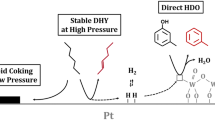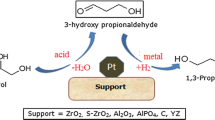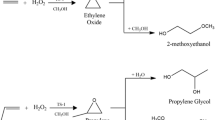Abstract
A systematic study of the comparative performances of supported Pt, Pd, Ru and conventional CoMo/Al2O3, NiMo/Al2O3, NiW/Al2O3 catalysts as well as the effects of solvent, H2 pressure and temperature on the hydroprocessing activity of a representative model bio-oil compound (e.g., p-cresol) is presented. With water as solvent, Pt/C catalyst shows the highest activity and selectivity towards hydrocarbons (toluene and methylcyclohexane), followed by Pt/Al2O3, Pd and Ru catalysts. Calculations indicate that the reactions in aqueous phase are hindered by mass-transfer limitations at the investigated conditions. In contrast, with supercritical n-heptane as solvent at identical pressure and temperature, the reactant and H2 are completely miscible and calculations indicate that mass-transfer limitations are eliminated. All the noble metal catalysts (Pt, Pd and Ru) show nearly total conversion but low selectivity to toluene in supercritical n-heptane. Further, conventional CoMo/Al2O3, NiMo/Al2O3 and NiW/Al2O3 catalysts do not show any hydrodeoxygenation activity in water, but in supercritical n-heptane, CoMo/Al2O3 shows the highest activity among the tested conventional catalysts with 97 % selectivity to toluene. Systematic parametric investigations with Pt/C and Pt/Al2O3 catalysts indicate that with water as the solvent, the reaction occurs in a liquid phase with low H2 availability (i.e., low H2 surface coverage) and toluene formation is favored. In supercritical n-heptane with high H2 availability (i.e., high H2 surface coverage), the ring hydrogenation pathway is favored leading to the high selectivity to 4-methylcyclohexanol. In addition to differences in H2 surface coverage, the starkly different selectivities between the two solvents may also be due to the influence of solvent polarity on p-cresol adsorption characteristics.












Similar content being viewed by others
Abbreviations
- \( a_{\text{b}} \) :
-
Gas–liquid interfacial area per unit volume of reactor, m2/m3
- \( a_{\text{p}} \) :
-
Liquid–solid interfacial area, m−1
- \( C_{\text{A}}^{ *} \) :
-
Saturation solubility of H2 in liquid phase, kmol/m3
- \( C_{\text{AS}} \) :
-
H2 concentration on the catalyst surface, kmol/m3
- \( D_{\text{e}} \) :
-
Effective diffusivity, m2/s
- \( d_{\text{i}} \) :
-
Impeller diameter, m
- \( D_{\text{M}} \) :
-
Molecular diffusivity, m2/s
- \( d_{\text{p}} \) :
-
Particle diameter, m
- \( d_{\text{t}} \) :
-
Reactor diameter, m
- \( H_{\text{e}} \) :
-
Henry’s law constant, kmol/m3/atm
- \( h_{\text{l}} \) :
-
Height of the first impeller from the bottom, m
- \( h_{2} \) :
-
Height of the liquid, m
- \( K_{\text{l}} \) :
-
Liquid film mass-transfer coefficient, m/s
- \( K_{\text{l}} a_{\text{b}} \) :
-
Overall gas–liquid mass-transfer coefficient, s−1
- \( K_{\text{s}} \) :
-
Liquid–solid mass-transfer coefficient, m/s
- \( m \) :
-
Order of reaction with respect to hydrogen
- \( M_{\text{w}} \) :
-
Molecular weight of solvent, g/mol
- \( n \) :
-
Moles of gas at constant pressure, kmol
- \( N \) :
-
Agitation speed, Hz
- \( N_{\text{p}} \) :
-
Power number
- \( P_{\text{H2}} \) :
-
Partial pressure of hydrogen, MPa
- \( R \) :
-
Universal gas constant, kJ/kmol/K
- \( R_{\text{H2}} \) :
-
Overall rate of hydrogenation, (kmol/m3) s−1
- \( r_{ \max }^{{}} \) :
-
Maximum rate of hydrogenation, (kmol/m3) s−1
- \( T \) :
-
Temperature, K
- \( V_{\text{g}} \) :
-
Volume of the gas in the reactor, m3
- \( V_{\text{l}} \) :
-
Volume of the liquid in the reactor, m3
- \( w \) :
-
Catalyst loading, kg/m3
- \( {{\upalpha}}_{ 1} \) :
-
Parameter defined by Eq. 1
- \( {{\upalpha}}_{ 2} \) :
-
Parameter defined by Eq. 3
- \( \phi_{ \exp } \) :
-
Parameter defined by Eq. 12
- \( \rho_{\text{l}} \) :
-
Density of liquid, kg/m3
- \( \mu_{\text{l}} \) :
-
Viscosity of liquid, centipoise
- \( \chi \) :
-
Association factor
- \( {{\upupsilon}}_{\text{M}} \) :
-
Molar volume of the solute, cm3/mol
- \( \rho_{\text{p}} \) :
-
Density of particle, kg/m3
- \( \in \) :
-
Porosity of the catalyst particle
- τ :
-
Tortuosity
References
Bridgwater AV, Peacocke GVC (2000) Renew Sustain Energy Rev 4:1
Demirbas A (2000) Energy Convers Managem 41:633
McKendry P (2002) Bioresour Technol 83:37
Yaman S (2004) Energy Convers Managem 45:651
Demirbas MF, Balat M (2006) Energy Convers Managem 47:2371
Meier D, Faix O (1999) Bioresour Technol 68:71
Islam MN, Beg MRA (2004) Bioresour Technol 92:181
Mohan D, Pittman CU, Steele PH (2006) Energy Fuels 20:848
Huber GW, Iborra S, Corma A (2006) Chem Rev 106:4044
Wright MM, Brown RC (2007) Biofuels Bioprod Bioref 1:49
Demirbas A (2001) Energy Convers Managem 42:1357
Bridgwater AV (1994) Appl Catal A Gen 116:5
Williams PT, Nugranad N (2000) Energy 25:493
Tang Y, Yu W, Mo L, Lou H, Zheng X (2008) Energy Fuels 22:3484
Miao S, Shanks BH (2009) Appl Catal A Gen 359:113
Tang Z, Lu Q, Zhang Y, Zhu X, Guo Q (2009) Ind Eng Chem Res 48:6923
Moens L, Black SK, Myers MD, Czernik S (2009) Energy Fuels 23:2695
Tang Z, Zhang Y, Guo Q (2010) Ind Eng Chem Res 49:2040
Putun E, Uzun BB, Putun AE (2009) Energy Fuels 23:2248
Wildschut J, Mahfud FH, Venderbosch RH, Heeres HJ (2009) Ind Eng Chem Res 48:10324
Vispute TP, Huber GW (2009) Green Chem 11:1433
Yang X, Chatterjee S, Zhang Z, Zhu X, Pittman CU Jr (2010) Ind Eng Chem Res 49:2003
Yakovlev VA, Khromova SA, Sherstyuk OV, Dundich VO, Ermakov DY, Novopashina VM, Lebedev MY, Bulavchenko O, Parmon VN (2009) Catal Today 144:362
Elliott DC (2007) Energy Fuels 21:1792
Elliott DC, Hart TR (2009) Energy Fuels 23:631
Elliott DC, Hart TR, Neuenschwander GG, Rotness LJ, Zacher AH (2009) Environ Progress Sustain Energy 28:441
Fisk CA, Morgan T, Ji Y, Crocker M, Crofcheck C, Lewis SA (2009) Appl Catal A Gen 358:150
Cortright RD, Davda RR, Dumesic JA (2002) Nature 418:964
Ford JW, Chaudhari RV, Subramaniam B (2010) Ind Eng Chem Res 49:10852
Czernik S, Bridgwater AV (2004) Energy Fuels 18:590
Ingram LL Jr, Mohan D, Bricka M, Steele P, Strobel DA, Crocker D, Mitchell BK, Mohammad J, Cantrell K, Pittman CU Jr (2008) Energy Fuels 22:614
Zhao C, Kou Y, Lemonidou AA, Li X, Lercher JA (2009) Angew Chem Int Ed 48:3987
Zhao C, Kou Y, Lemonidou AA, Li X, Lercher JA (2010) Chem Commun 46:412
Zhao C, He J, Lemonidou AA, Li X, Lercher JA (2011) J Catal 280:8
Sugii T, Kamiya Y, Okuhara T (2006) Appl Catal A Gen 312:45
Oasmaa A, Czernik S (1999) Energy Fuels 13:914
Fonts I, Kuoppala E, Oasmaa A (2009) Energy Fuels 23:4121
Yang X, Chatterjee S, Zhang Z, Zhu X, Pittman CU Jr (2010) Ind Eng Chem Res 49:2003
Graca I, Ribeiro FR, Cerqueira HS, Lam YL, de Almeida MBB (2009) Appl Catal B Environ 90:556
Alcala R, Mavrikakis M, Dumesic JA (2003) J Catal 218:178
Laurent E, Delmon B (1994) J Catal 146:281
Pray HA, Schweickert CE, Minnich BH (1952) Ind Eng Chem 44:1146
Ramachandran PA, Chaudhari RV (1983) Three phase catalytic reactors. Gordon & Breach, New York
Patil NG, Roy D, Chaudhari AS, Chaudhari RV (2007) Ind Eng Chem Res 46:3243
Faglioni F, Goddard WA III (2005) J Chem Phys 122:1
Eijsbouts S (1997) Appl Catal A Gen 158:53
Gainza AE, Ruette F, Rodriguez-Arias EN (1993) J Mol Catal 85:345
Xu H, Friend CM (1993) J Phys Chem 97:3584
Rufael TS, Huntley DR, Mullins DR, Gland JL (1994) J Phys Chem 98:13022
Centeno A, Laurent E, Delmon B (1995) J Catal 154:288
Tanksale A, Beltramini JN, Lu GQ (2006) Develop Chem Eng Min Process 14:9
Gholap RV, Chaudhari RV, Hofmann H (1987) Can J Chem Eng 65:744
Sano Y, Yamaguchi N, Adachi T (1974) J Chem Eng Jpn 1:255
Wilke CR, Chang P (1955) AIChE J 1:264
Calderbank PH (1958) Trans Inst Chem Eng 36:443
Acknowledgments
Funding for this work was provided by US Department of Agriculture (Grant 2011-10006-30362) and core funds from the Center for Environmentally Beneficial Catalysis (CEBC) at the University of Kansas. Helpful discussions with Drs Juan J. Bravo Suarez and Debdut Roy are gratefully acknowledged.
Author information
Authors and Affiliations
Corresponding author
Appendix: Criteria for Evaluating Significance of Mass-Transfer Limitations
Appendix: Criteria for Evaluating Significance of Mass-Transfer Limitations
(a) Gas–liquid mass-transfer resistance is considered insignificant if
where \( K_{\text{l}} a_{\text{b}} \) is the gas–liquid mass-transfer coefficient and is calculated according to the correlation proposed by Gholap and co-workers [52].
(b) Liquid–solid mass-transfer limitation is considered unimportant if
where \( a_{\text{p}} \), the external surface area of the catalyst per unit volume for spherical particles is given by
and \( K_{\text{s}} \) is the liquid–solid mass-transfer coefficient and is estimated by the correlation proposed by Sano and co-workers [53].
where \( F_{\text{c}} \) is the shape factor (assumed to be unity for spherical particles) and \( D_{\text{M}} \) is the molecular diffusivity calculated by using the correlation proposed by Wilke and Chang [54].
and e is the energy supplied calculated by using the correlation proposed by Calderbank [55].
where \( \psi \) is the correction factor for the presence of gas bubbles calculated by using the correlation proposed by Calderbank [55].
where \( Q_{\text{g}} \) is the volumetric flow rate (m3/s) of gas calculated by using the formula
where \( V_{\text{M}} \) is the molar gas volume (m3/kmol) calculated by using the formula
(c) Pore diffusion resistance can be considered to be insignificant if
where \( D_{\text{e}} \) is the effective diffusivity and is calculated by using the formula
If gas–liquid mass-transfer limitation is significant, \( C_{\text{A}}^{ *} \) is replaced by \( C_{\text{AS}} \) which is calculated by using the formula
Rights and permissions
About this article
Cite this article
Wan, H., Chaudhari, R.V. & Subramaniam, B. Catalytic Hydroprocessing of p-Cresol: Metal, Solvent and Mass-Transfer Effects. Top Catal 55, 129–139 (2012). https://doi.org/10.1007/s11244-012-9782-6
Published:
Issue Date:
DOI: https://doi.org/10.1007/s11244-012-9782-6




